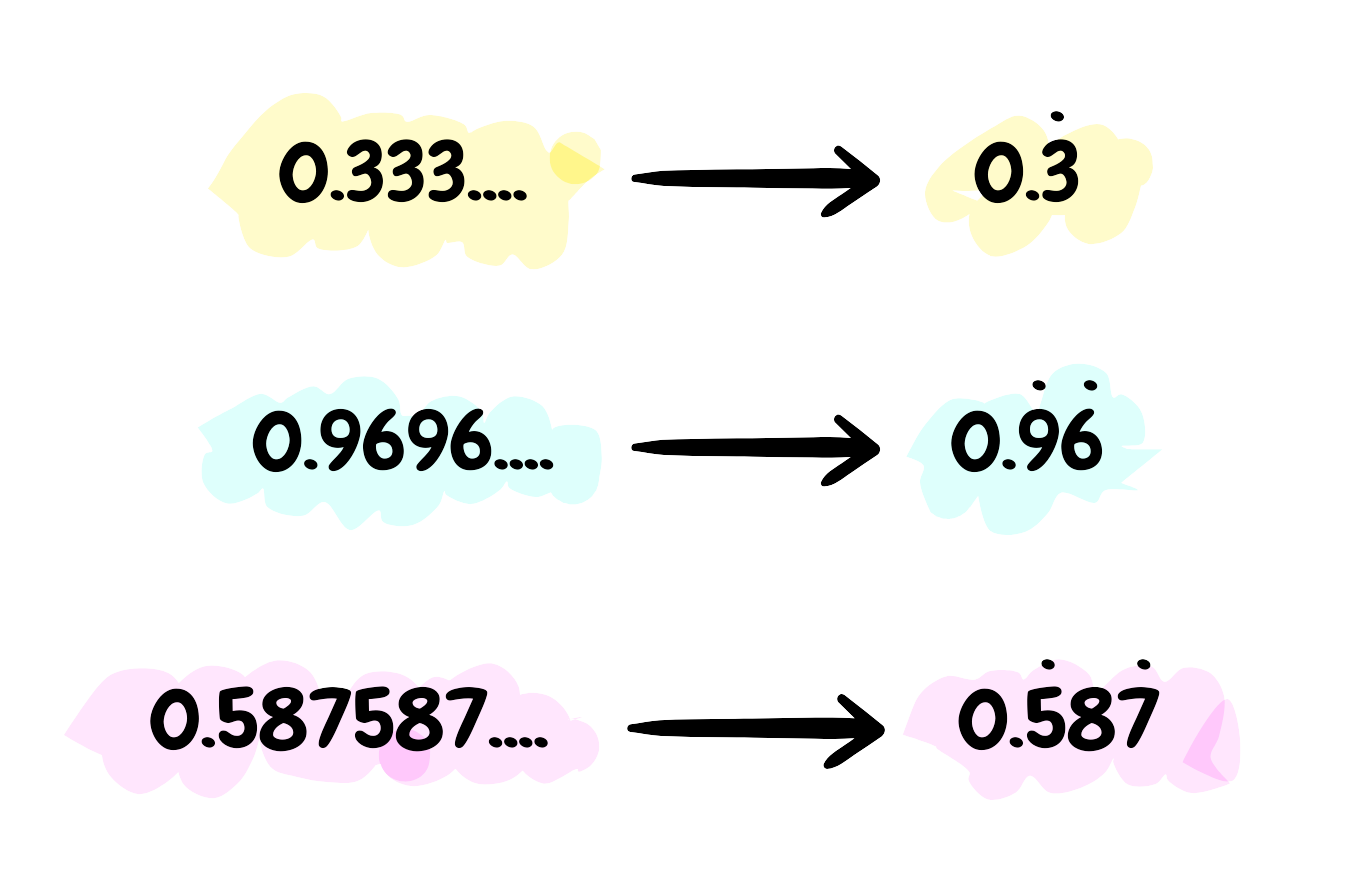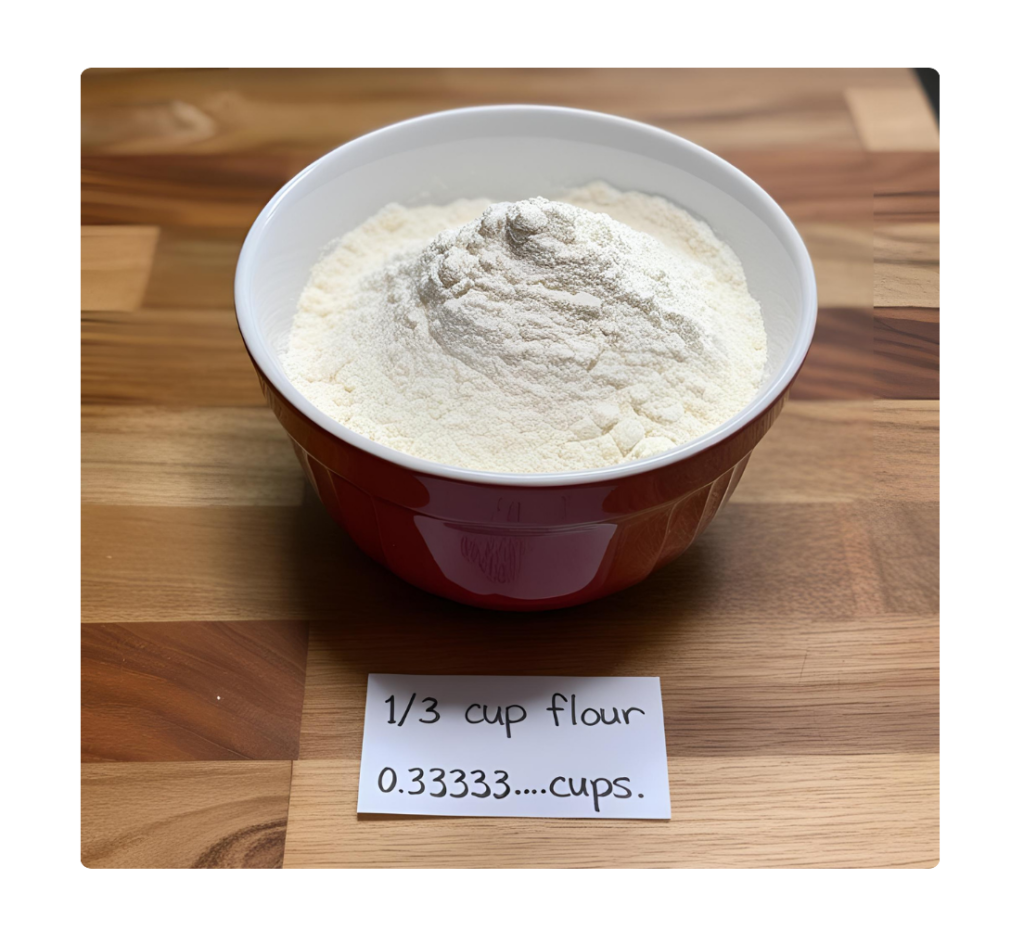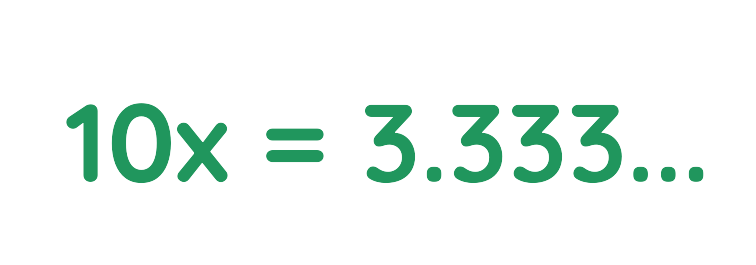Decimal Recurring to Fraction
Introduction
- A Recurring Decimal is denoted with a dot over the number and is any decimal in which the digits repeat themselves.

Types of Recurring Decimals
Pure Recurring Decimals:
- Decimal where all the digits after the decimal point repeat indefinitely.
Examples:
- 0.333…
- 0.7474….
- 0.4545….
- 0.98549854….
Mixed Recurring Decimals:
- After the decimal point, some digits do not repeat, and a sequence of digits starts repeating indefinitely after the non-repeating part.
Examples:
- 0.23434….
- 0.165858….
- 0.2358989….
- 0.7852222….
How to Convert Recurring Decimals to Fractions (Type 1)
Type 1: Converting Pure Recurring Decimals to Fraction:
Step#1: Take your term as x.
Step#2: Multiply both sides by 10n (where n is the number of repeating digits).
- Multiply 10 for 1 Recurring Decimal.
Example:
For 0.333…, there is only 1 digit repeat, so multiply by
101 = 10
So, 10x = 3.333…
- Multiply 100 for 2 Recurring Decimal.
Example:
For 0.2929…, there is 2 digits repeat, so multiply by
102 = 100
So, 100x = 29.2929…
- Multiply 1000 for 3 Recurring Decimal.
Example:
For 0.816816…, there is 3 digits repeat, so multiply by
103 =1000
So, 1000x = 816.816816…
Step#3: Subtract original equation from new equation to eliminate the repeating part.
Step#4: Solve for x and simplify fraction, if possible.
How to Convert Recurring Decimals to Fractions (Type 2)
Type 2: Converting Mixed Recurring Decimals to Fraction:
Step#1: Take your term as x.
Step#2: Multiply both sides by 10 (where m is the number of non-repeating digits).

Step #3: Multiply both sides by 10n (where n is the number of repeating digits) to shift the Decimal.
Step#4: Subtract original equation from new equation to eliminate the repeating part.
Step#5: Solve for x and simplify fraction, if possible.
 Solved Example
Solved Example
Problem: Convert 0.12323… into Fraction.
Solution:
Step #1: Let x = 0.12323…
Step #2: Multiply both side by 101 =10 to move the non-repeating part:

Step #3: Multiply both sides by 102 =100 to shift the Decimal:

Step #4: Subtract the original equation from this new equation:

Step #5: Solve for x:

Final Answer: 61/495
Why it is important to convert Recurring Decimals into Fraction?
- Converting recurring decimals into fractions is important because recurring decimals are approximations of fractions, but fractions provide an exact representation of the number.
Examples:
- A recipe might call for 1/3 cup of flour, which is more practical than 0.3333… cups.

- If a bank offers an interest rate of 0.3333… it’s easier to express it as 1/3 to simplify calculations.

- In Chemistry, Mole ratios in reactions often involve fractions (e.g., 0.1666… moles = 1/6 mole).

Three Additional Solved Examples
 Solved Example 1
Solved Example 1
Problem: Convert 0.333… into Fraction.
Solution:
Step #1: Let x = 0.333…
Step #2: Multiply both side by 10:

Step #3: Subtract the original equation from this new equation:

Step #4: Solve for x:

Final Answer: 1/3
 Solved Example 2
Solved Example 2
Problem: Convert 0.181818… into Fraction.
Solution:
Step #1: Let x = 0.1818…
Step #2: Multiply both side by 100:

Step #3: Subtract the original equation from this new equation:

Step #4: Solve for x:

Final Answer: 2/11
 Solved Example 3
Solved Example 3
Problem: Convert 0.6333… into Fraction
Solution:
Step #1: Let x = 0.6333…
Step #2: Multiply both side by 101 =10 to move the non-repeating part:

Step #3: Multiply both sides by 102 =100 to shift the Decimal:

Step #4: Subtract the original equation from this new equation:

Step #5: Solve for x:

Final Answer: 19/30
Practice Questions and Answers on Decimal Recurring to Fraction
Question 1: Convert the Pure Recurring Decimal 0.121212… to a fraction.
Question 2: Convert the Pure Recurring Decimal 0.2222… to a fraction.
Question 3: Convert the Pure Recurring Decimal 0.090909… to a fraction.
Question 4: Convert the Pure Recurring Decimal 0.142142… to a fraction.
Question 5: Convert 0.479479… form of Pure Recurring decimal to a fraction.
Question 6: Convert the Mixed Recurring Decimal 2.333… to a fraction.
Question 7: Converting the Mixed Recurring Decimal 0.10909… to a fraction.
Question 8: Converting the Mixed Recurring Decimal 0.5666… to a fraction.
Question 9: Convert the Mixed Recurring Decimal 2.272727… to a fraction.
Question 10: Convert the Pure Recurring Decimal 0.5555… to a fraction.
Solutions
Question 1:
Solution:
Step#1: Let x = 0.1212…
Step#2: Multiply both sides by 100
100x = 12.1212…
Step#3: Subtract the original equation
100x − x = 12.1212… − 0.1212…
99x = 12
Step#4: Solve for x
x = 12 ÷ 99
= 4 ÷ 33
Answer: 4/33
Question 2:
Solution:
Step#1: Let x = 0.2222…
Step#2: Multiply both sides by 10
10x = 2.222…
Step#3: Subtract the original equation
10x − x = 2.222… − 0.222…
9x = 2
Step#4: Solve for x
x = 2 ÷ 9
Answer: 2/9
Question 3:
Solution:
Step#1: Let x = 0.090909…
Step#2: Multiply both sides by 100
100x = 9.0909…
Step#3: Subtract the original equation
100x − x = 9.0909… − 0.0909…
99x = 9
Step#4: Solve for x
x = 9 ÷ 99
= 1 ÷ 11
Answer: 1/11
Question 4:
Solution:
Step#1: Let x = 0.142142…
Step#2: Multiply both sides by 1000
1000x = 142.142142…
Step#3: Subtract the original equation
1000x − x = 142.142142… − 0.142142…
999x = 142
Step#4: Solve for x
x = 142 ÷ 999
Answer: 142/999
Question 5:
Solution:
Step#1: Let x = 0.479479…
Step#2: Multiply both sides by 1000
1000x = 479.479479…
Step#3: Subtract the original equation
1000x − x = 479.479479… − 0.479479…
999x = 479
Step#4: Solve for x
x = 479 ÷ 999
Answer: 479/999
Question 6:
Solution:
Step#1: Let x = 2.333…
Step#2: Multiply both sides by 10
10x = 23.333…
Step#3: Subtract the original equation
10x − x = 23.333… − 2.333…
9x = 21
Step#4: Solve for x
x = 21 ÷ 9 = 7 ÷ 3
Answer: 7/3
Question 7:
Solution:
Step#1: Let x = 0.10909…
Step#2: Multiply both sides by 10
10x = 1.0909…
Step#3: Multiply both sides again by 100
1000x = 109.0909…
Step#4: Subtract
1000x − 10x = 109.0909… − 1.0909…
990x = 108
Step#5: Solve for x
x = 108 ÷ 990
= 6 ÷ 55
Answer: 6/55
Question 8:
Solution:
Step#1: Let x = 0.5666…
Step#2: Multiply both sides by 10
10x = 5.666…
Step#3: Multiply both sides again by 10
100x = 56.666…
Step#4: Subtract
100x − 10x = 56.666… − 5.666…
90x = 51
Step#5: Solve for x
x = 51 ÷ 90 = 17 ÷ 30
Answer: 17/30
Question 9:
Solution:
Step#1: Let x = 2.2727…
Step#2: Multiply both sides by 100
100x = 227.2727…
Step#3: Subtract
100x − x = 227.2727… − 2.2727…
99x = 225
Step#4: Solve for x
x = 225 ÷ 99 = 25 ÷ 11
Answer: 25/11
Question 10:
Solution:
Step#1: Let x = 0.555…
Step#2: Multiply both sides by 10
10x = 5.555…
Step#3: Subtract the original equation
10x − x = 5.555… − 0.555…
9x = 5
Step#4: Solve for x
x = 5 ÷ 9
Answer: 5/9
Table of Content
- Introduction
- Types of Recurring Decimals
- How to convert Recurring Decimals to Fractions (Type 1)
- How to convert Recurring Decimals to Fractions (Type 2)
- Why it is important to convert Recurring Decimals into Fraction?
- Three Additional Solved Examples
- Practice Questions and Answers on Decimal Recurring to Fraction

